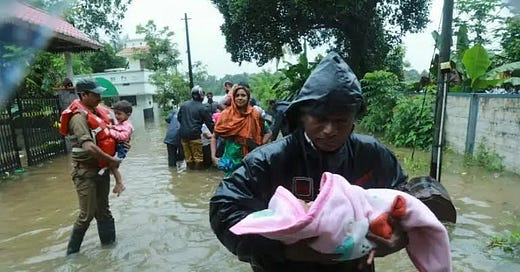"Are we on the Same Boat?": Caste and its Role in the 2018 Kerala Floods
Words by Adithya Santhosh Kumar
Welcome to the Brown History Newsletter. If you’re enjoying this labour of love, please do consider becoming a paid subscriber. Your contribution would help pay the writers and illustrators and support this weekly publication. If you like to submit a writing piece, please send me a pitch by email at brownhistory1947@gmail.com.
Don’t forget to check out our SHOP and our Podcast.
“Are we on the Same Boat?”: Caste and its Role in the 2018 Kerala Floods
Cradled on the southwestern coast of India lies Kerala, known for its breathtaking backwaters and luscious greenery. Often touted as “God’s Own Country”, Kerala has been hailed as a paradise on Earth, with tourists flocking in by the thousands from across the globe. However, amidst the pristine and picturesque sceneries, Kerala’s utopian landscape can metamorphose into a cauldron of tumultuous unrest when the rains of monsoon descend. The year 2018 witnessed an unprecedented calamity that disrupted the tranquillity of the Malabar coast – a cataclysmic deluge – the Kerala floods of 2018. In a turn of events, the same natural abundance that graced the state became the catalyst for one of the most destructive disasters in its history. The response to this catastrophe was prompt, with volunteers, government agencies, and the armed forces working in tandem to carry out rescue operations. However, in an emergency that called for collective action, there were reports of caste-based discrimination in various parts of the state. Activists and social organisations rallied to promote inclusivity and sensitivity amongst the population. While there was overwhelming solidarity and unity on display, it is imperative to highlight the experiences of the ostracised and marginalized.





